|
Printables |
PowerPoints |
Online exercises |
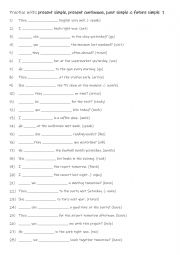
|
A1+-A2 Practise with present simple, present continuous, past simple & future simple 1
Students should practise the present simple, present continuous, past simple, and future simple because these tenses are the foundation of effective communication. The present simple is used for habits, routines, and facts, while the present continuous describes ongoing or temporary actions. The past simple helps in narrating completed actions and ...
Level: elementary
Age: 8-100
Type:
Downloads: 129
|
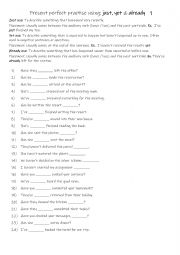
|
A1+-A2 Present perfect practise using just, yet & already 1
Learning the present perfect tense with just, yet, and already is essential because these time adverbs allow students to express recent actions, expectations, and accomplishments clearly and concisely. Just helps highlight very recent actions (e.g., I have just finished my homework), making communication precise and current. Yet is vital for asking...
Level: elementary
Age: 9-100
Type:
Downloads: 116
|
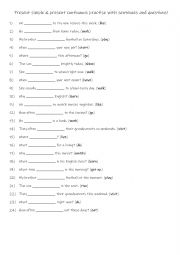
|
A1+-A2 Present simple & present continuous practise with sentences and questions!
Students read the sentences to see which tense is required to complete the sentences with the given verb in () in bold. Each tense is used 12 times allowing for plenty of practise. Answers on page 2.
Level: elementary
Age: 7-100
Type:
Downloads: 111
|
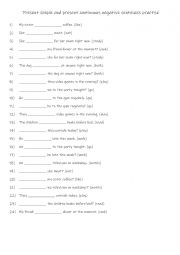
|
A1+-A2 Present simple and present continuous negative sentences practise
Students read the sentences to see which negative tense is needed to complete the sentence using the infinitive in () at the end of each sentence. Answers on page 2
Level: elementary
Age: 8-100
Type:
Downloads: 105
|
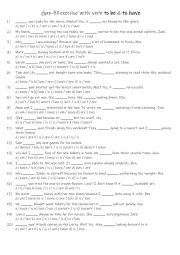
|
A1+-A2 Present simple multiple choice with verb to be & to have
Students read the present simple sentences to see which auxiliary verb is needed to complete the gap-fills. Answers on page 2.
Level: elementary
Age: 8-100
Type:
Downloads: 107
|
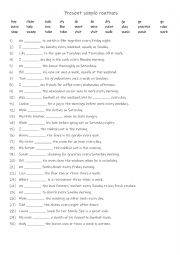
|
A1+-A2 Present simple routines + 3rd person practise
Learning present simple routines with these verbs is useful because it helps describe everyday actions in English, which is important for basic conversation. The present simple tense is used to talk about habits and routines, so knowing these verbs allows students to share information about daily life, like "I wash dishes every evening" or "She vis...
Level: elementary
Age: 8-100
Type:
Downloads: 129
|
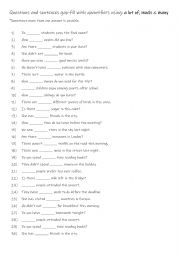
|
A1+-A2 Questions and sentences gap-fill with quantifiers using a lot of, much & many
Students complete the sentences using a suitable given quantifier in bold. Answers on page 2.
Level: elementary
Age: 8-100
Type:
Downloads: 123
|
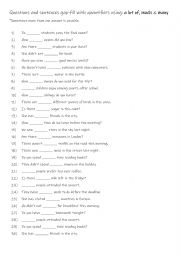
|
A1+-A2 Questions and sentences gap-fill with quantifiers using a lot of, much & many
Students read the sentences to see which quantifier is required to complete the gap-fill. Answers on page 2.
Level: elementary
Age: 8-100
Type:
Downloads: 123
|
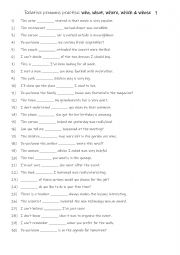
|
A1+-A2 Relative pronouns practise who, what, where, which & whose 1
Practising relative pronouns like who, what, where, which, and whose is essential for students as it helps them connect ideas, create complex sentences, and improve the overall clarity of their communication. By specifying people, places, or things, relative pronouns make sentences more precise and cohesive, enhancing both writing and speaking skil...
Level: elementary
Age: 8-100
Type:
Downloads: 122
|
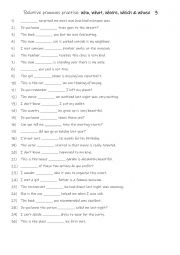
|
A1+-A2 Relative pronouns practise who, what, where, which & whose 3
Mastery of these pronouns also builds grammatical accuracy, making students more confident in formal and informal contexts. First, students need to familiarise themselves with the pronouns and their use. Then they read the sentences to see which one is needed to complete the sentence. Answers on page 2.
Level: elementary
Age: 9-100
Type:
Downloads: 115
|
|
|
|
|












